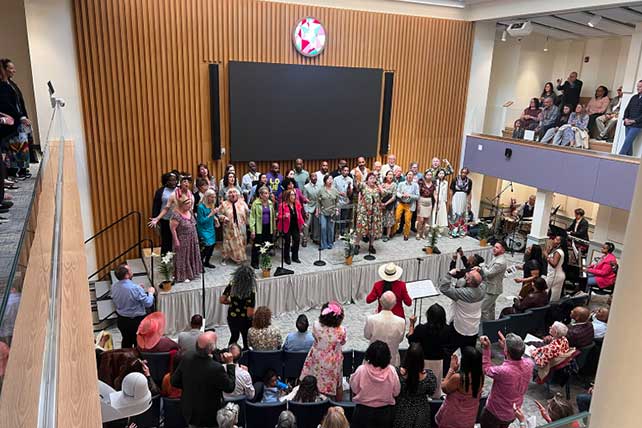NEW YORK (RNS) — As she approached the pulpit on Easter Sunday (April 20), the Rev. Jacqueline J. Lewis, the senior minister of Middle Collegiate Church, couldn’t hold back her tears. It was the first time the congregation had gathered in a building it could call its own since a December 2020 fire destroyed the historic church’s 128-year-old home.
“I’m so glad you’re here, in this incredible moment, on this incredible historic day, when we come back home,” Lewis told the congregation dressed in their Easter finery.
The morning worship service, led by Middle’s choir, drew hundreds of people who came to celebrate both Christ’s resurrection and Middle Collegiate’s rising from the ashes of the devastating fire, which not only left the congregation homeless but prompted churchwide soul searching about their future.
RELATED: Manhattan’s Middle Collegiate Church Begins Façade Demolition
The years of scrambling to preserve the church’s mission during renovations, the senior minister said, were trying, but affirmed for her the value of the community. “The larger project, to me, wasn’t raising the money. The larger project was to continue to raise hope and a sense of resilience and a sense of joy that we got this,” she said.
In the winter of 2020 and 2021, just as many other New York congregations were returning to in-person services after COVID-19 lockdowns, Middle had to remain online. But Lewis knew the group had a will to gather. “Being placeless was a challenge for our people. … You’re in the wilderness and you yearn for home,” she said. They tapped interfaith connections to find shared space at Calvary Church-St. George’s, an Episcopal church in the Gramercy Park neighborhood, and later East End Temple in the Lower East Side and Judson Memorial Church in the West Village.
Firefighters work to extinguish a fire that erupted from the building next to Middle Collegiate Church on Dec. 5, 2020, in New York. The historic 19th-century church in lower Manhattan was gutted by a massive fire that sent flames shooting through the roof. (AP Photo/Yuki Iwamura)
Meanwhile, the church’s leadership worked to rebuild its sanctuary by incorporating what remained of the neo-Gothic facade of the 1892 church and its back wall, which had survived the fire, but barely. In the end, they were too damaged to be used, and after permission from New York City’s Landmarks Preservation Commission was secured, the decision was made to demolish the walls. In November 2023, congregants watched them go down from the same corner they’d watched the church burn down, adding “another layer of grief,” said Lewis.
The facade’s demolition, however, freed up funds that had been going to propping it up, giving the renovation a fresh start. As a new church was planned, the congregation shifted its worship to a social hall for the church whose front door was around the corner, at 50 E. Seventh St. Though it was severely damaged by water used to put out the fire, this annex building was whole enough to serve as a new sanctuary.
Lewis, quoting a verse from the Bible’s Book of Isaiah — “I am doing a new thing: now it springs forth, do you not perceive it?” — said the community sees a biblical sign in this former social space being repurposed.

The Rev. Jacqueline J. Lewis speaks during the Middle Collegiate Church Easter service, April 20, 2025, in New York. (Photo courtesy of Middle Collegiate Church)
As the last parts of the former sanctuary vanished, the congregation, founded in 1628 by Reformed Dutch settlers, also turned to reinventing its identity, said Lewis. “Without the facade, we’re still us. Without the facade, there’s even a stronger future opportunity. We get to start from scratch on that lot, and see what it is that God is calling us to build,” she said.


